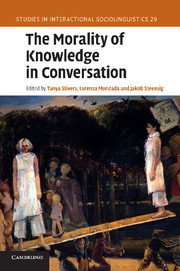Book contents
- Frontmatter
- Contents
- Contributors
- Preface
- Acknowledgements
- List of transcription and glossing symbols
- Part I Introduction
- Part II Affiliational consequences of managing epistemic asymmetries
- Part III Epistemic resources for managing affi liation and alignment
- Part IV Toward a framework
- 12 Sources of asymmetry in human interaction: enchrony, status, knowledge and agency
- References
- Index
12 - Sources of asymmetry in human interaction: enchrony, status, knowledge and agency
Published online by Cambridge University Press: 05 November 2011
- Frontmatter
- Contents
- Contributors
- Preface
- Acknowledgements
- List of transcription and glossing symbols
- Part I Introduction
- Part II Affiliational consequences of managing epistemic asymmetries
- Part III Epistemic resources for managing affi liation and alignment
- Part IV Toward a framework
- 12 Sources of asymmetry in human interaction: enchrony, status, knowledge and agency
- References
- Index
Summary
As conversation analysis forges new directions, it also faces significant challenges in a world of developing research, and shifting research interests. My purpose in this chapter is to address one of these challenges: to define more explicitly the elements of a framework that will license and constrain the observed structures of social interaction, and in turn their proper analysis. Part of the goal is to offer an account of human interaction that is general enough to address broader, interdisciplinary questions of the study of human behavior.
I aim to explicate a theoretical foundation for understanding the kinds of phenomena dealt with in the above chapters – that is, the negotiation of knowledge, responsibility and affiliation in interaction – building on four related concepts: enchrony, status, knowledge and agency. Each builds from the next, where enchrony entails accountability, status relativizes it, knowledge grounds it, and agency distributes it. Each is a source of asymmetry, and each thereby plays a role in defining a possibility space in the morality of knowledge in communication. The four concepts are well established in existing literature, although they may be known by other names, and may not have been brought together in quite the same way as here.
Enchrony
Our first element is a primal driving force for the ever-forward progression of social interaction, a force from which we derive sequence (Schegloff 2007b), from its simplest to its most complex manifestations.
- Type
- Chapter
- Information
- The Morality of Knowledge in Conversation , pp. 285 - 312Publisher: Cambridge University PressPrint publication year: 2011
- 76
- Cited by

